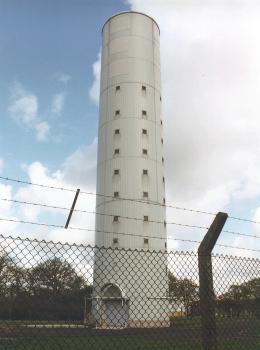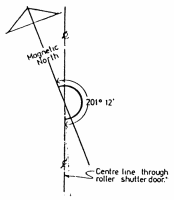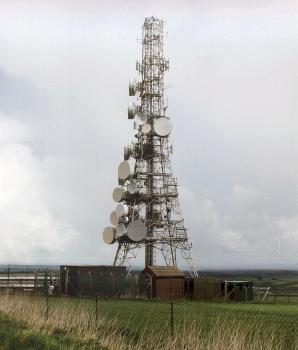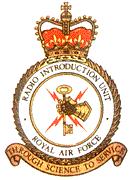Back to The Capenhurst Tower home page.
Ministry of Defence hid microwave phone-tap tower inside nuclear plant |
||
|
||
|
It is also located right on the microwave line-of-sight between two British Telecom radio towers at Gwaenysgor in North Wales and Pale Heights in Cheshire. The BT towers form part of a chain carrying thousands of phone lines from England, along the north Wales coast to Anglesey, then across the Irish Sea to Dublin. Four microwave channels ran in each direction, each capable of carrying one TV channel or roughly 1,000 phone calls, using frequencies around 6.5 GHz.
Although the BT aerials are very directional, the beam spreads out about 1° either side of the centre line. [1] By the time the signal from Pale Heights reaches Capenhurst, the beam is roughly 650 metres wide, although there is a gradual decline rather than a sharp cutoff. The Gwaenysgor tower is further away, so its beam will be even wider. BT is obliged by the terms of its Oftel licence to provide phone taps for the secret services or police if a warrant has been obtained from the Home Secretary or Foreign Secretary. The fact that the Ministry of Defence, which operated the site, went to a lot of trouble and expense to tap BT's trunk lines behind its back, will confirm fears amongst civil libertarians that the government has been engaged in systematic tapping without warrants. The tower was designed in 1988 by Chester-based architects Lovelock Mitchell and Partners. Their drawing describes the tower as an ``electronics testing facility'' for Serco. The drawing suggests that the roller shutter doors had to be aligned on an exact compass bearing, specified to a fraction of one degree. In reality it was the radio-transparent fibreglass `dielectric windows' directly above and at right angles with the doors that needed accurate alignment. (The roof dome was also made of fibreglass, and this could have been used to hide a satellite link to get intelligence data out.) |
||
|
||
|
Serco is a private contractor which operates a number of sensitive defence facilities for the government, including key parts of the RAF's `Ballistic Missile Early Warning System' radar station at Fylingdales in North Yorkshire. The Capenhurst site was surveyed extensively before the exact spot to locate the tower was chosen. The MoD then bought a plot of land for it specially, despite already owning many other plots of land nearby. Although access to the site could have been obtained from an existing road to the site, Manorfield Close, this was fenced off and a gate installed in BNFL's boundary fence instead. When it was operational, staff worked at the tower 24 hours a day, and came through BNFL's main gate on their way there. To this day workers at the plant, which manufactures enriched uranium for nuclear power stations, have no idea what went on behind their backs. Some of them got it nearly right: they guessed it was a GCHQ intercept site to monitor Russian naval activity in the Irish Sea. The tower has twelve dielectric windows, spaced exactly 90 degrees apart on the top three storeys of the 13-storey tower. Six of the windows line up accurately with the two British Telecom towers. The other six may be decoys to disguise the tower's purpose, or they could have been used for other aerials aimed at other sites. The northernmost windows had an equipment hoist behind them, which could lift equipment through trapdoors in the floors. This suggests that it was never intended to use the northernmost windows for aerials (because the hoist and the aerials would have got in each others way), thus supporting the idea that the `unused' windows were decoys. |
||
|
||
|
Eight of the tower's 13 storeys were air-conditioned. The drawing shows that each of these eight storeys had no less than four air conditioners. These got rid of their waste heat via the 32 small grilles in the side of the tower. The heavy-duty electricity supplies and air conditioning suggests that the microwave signals may have been broken down into individual telephone channels on site, and phone calls selected against pre-determined criteria (e.g. the number called) by powerful computers for further analysis. According to the Defence Estate Organisation, the installation was operated by the RAF's `Radio Introduction Unit' (RIU). The RIU's crest appears on the RAF's web site, along with this description: |
||
|
||
|
The RAF has often acted as a `front' organisation for GCHQ and its American big brother(!), the National Security Agency. The radio intercept station at nearby Cheadle, Staffs was known as `RAF Cheadle', and `RAF Menwith Hill' in Yorkshire is the site of the largest American intelligence gathering base outside the USA itself. For decades, NSA, GCHQ and other partner agencies have attempted to tap many different international communications links, [6][7] but this is the first time a covert terrestrial microwave intercept has been found in the UK. The tower appears to have been operated from about 1990 to 1994, when apparently it was abandoned. Recently it came onto the market, along with hundreds of other defence sites, for sale to private owners. Several mobile phone companies have been to have a look at it and it was not long before engineers who visited the site guessed its sinister purpose. References1. International Frequency List, March 1996, published by the ITU on CD-ROM.2. Architect's drawing: floor plans. 3. Architect's drawing: elevations. 4. RIU article formerly on RAF web site and still available courtesy of the Internet Archive's Wayback Machine. 5. Ordnance Survey Sheet 117, 1986 edition. 6. The Puzzle Palace by James Bamford. (Penguin, 1983) 7. The Unsinkable Aircraft Carrier by Duncan Campbell. (Michael Joseph, 1984) Acknowledgements and CopyrightsThe RIU crest is Crown Copyright. Lovelock Mitchell and Partners own the copyright in the architects drawings. Both have been reproduced under the `public interest' provisions of the Copyright, Designs and Patents Act 1988. The remainder of this article, including photographs and drawings, is Copyright © 1999 Richard Lamont.Back to The Capenhurst Tower home page. |




